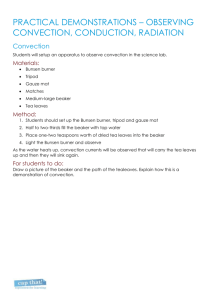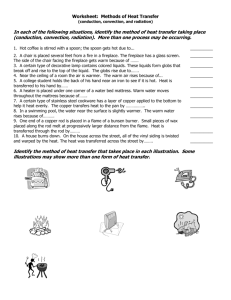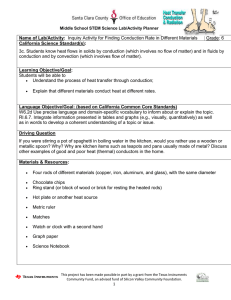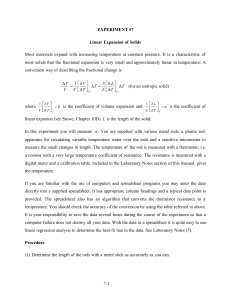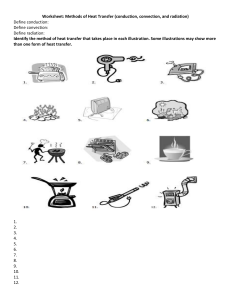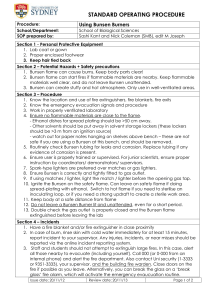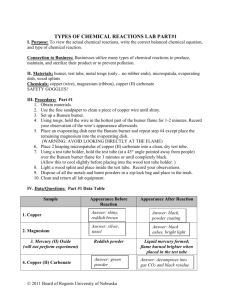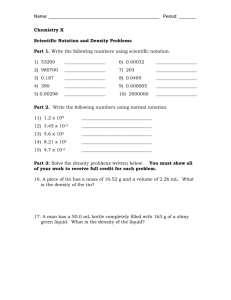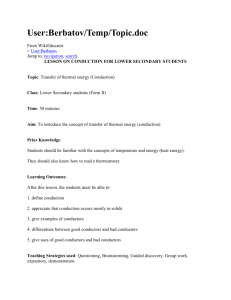Conduction of heat
advertisement
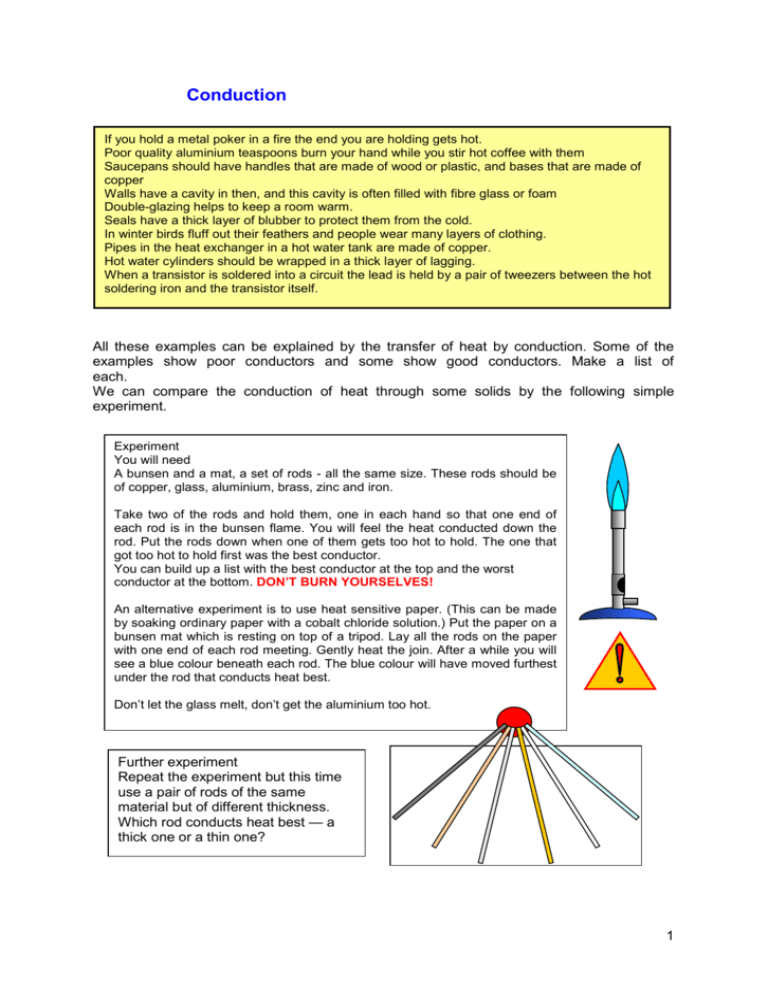
Conduction If you hold a metal poker in a fire the end you are holding gets hot. Poor quality aluminium teaspoons burn your hand while you stir hot coffee with them Saucepans should have handles that are made of wood or plastic, and bases that are made of copper Walls have a cavity in then, and this cavity is often filled with fibre glass or foam Double-glazing helps to keep a room warm. Seals have a thick layer of blubber to protect them from the cold. In winter birds fluff out their feathers and people wear many layers of clothing. Pipes in the heat exchanger in a hot water tank are made of copper. Hot water cylinders should be wrapped in a thick layer of lagging. When a transistor is soldered into a circuit the lead is held by a pair of tweezers between the hot soldering iron and the transistor itself. All these examples can be explained by the transfer of heat by conduction. Some of the examples show poor conductors and some show good conductors. Make a list of each. We can compare the conduction of heat through some solids by the following simple experiment. Experiment You will need A bunsen and a mat, a set of rods - all the same size. These rods should be of copper, glass, aluminium, brass, zinc and iron. Take two of the rods and hold them, one in each hand so that one end of each rod is in the bunsen flame. You will feel the heat conducted down the rod. Put the rods down when one of them gets too hot to hold. The one that got too hot to hold first was the best conductor. You can build up a list with the best conductor at the top and the worst conductor at the bottom. DON’T BURN YOURSELVES! An alternative experiment is to use heat sensitive paper. (This can be made by soaking ordinary paper with a cobalt chloride solution.) Put the paper on a bunsen mat which is resting on top of a tripod. Lay all the rods on the paper with one end of each rod meeting. Gently heat the join. After a while you will see a blue colour beneath each rod. The blue colour will have moved furthest under the rod that conducts heat best. Don’t let the glass melt, don’t get the aluminium too hot. Further experiment Repeat the experiment but this time use a pair of rods of the same material but of different thickness. Which rod conducts heat best — a thick one or a thin one? 1 More experiments 1. Hold your hand beside a bunsen flame and about 10 cm away from it. How hot does it feel? What does this tell you about how well air conducts heat. 2. Using the composite rod shown in the diagram you can compare how well copper and wood conduct heat. Wind a piece of paper round the join, stick it down and heat the junction with a blue bunsen flame. What happens? Which side of the paper chars first and why? copper wood 3. Take a piece of fine copper gauze and hold it in the bunsen flame so that the gauze is resting on the top of the metal of the bunsen. Now very slowly lift up the gauze. With luck you should be able to lift the flame up as well! Why do you think this is? (Teacher demonstration) Explanation. The heat is conducted away through the copper gauze and the gas below it is not hot enough to catch fire. This experiment explains the working of the Davy Safety lamp used by miners in the 19th century. 4. Put a small piece of ice at the bottom of a test tube and hold it in place by jamming a piece of copper gauze after it. Fill the test tube with water. Now heat the water at the top of the test tube with a bunsen so that it boils. What happens to the ice? What does this tell you about how well water conducts heat? Eye protection advised These experiments should have shown you that: Some materials conduct heat better than others Metals conduct heat better than non-metals Thick specimens conduct heat better than thin ones Liquids are poor conductors of heat Air is a very bad conductor of heat The following list shows some common materials, starting with the ones that conduct heat best and ending with the worst conductors: silver copper aluminiun brass iron zinc lead rock water glass rubber air 2 Air as an insulator Air is such a bad conductor that we often use it to help keep things warm. Layers of clothing have air pockets in then to keep our bodies warm in cold weather. For the same reason birds fluff up their feathers in winter. The cavity walls in houses are often filled with foam to stop the air from moving about and dragging in cold air from outside. Lofts have layers of fibreglass in them to trap air pockets - and windows are double glazed for the same reason. Some windows have a vacuum between the double glazed panels so there is nothing at all to conduct the heat through. What causes conduction? When you heat one end of a solid rod the atoms (or molecules) at that end vibrate – the more it is heated the more they vibrate. This vibration is passed on from one atom to the next as they are all linked together in the solid. Conduction This is just like the vibrations passing down a slinky spring. The energy is transferred down the rod and this is conduction. However, in metals there are also a lot of free electrons wandering about and these play a big part in the energy transfer. Hot – large molecular energy and vibration Cold – small molecular energy and vibration Atom (or molecule) Questions 1. Why does wrapping them in layers of newspaper help to keep fish and chips hot? 2. Why does it feel colder if you walk on tiles in bare feet than if you walk on a carpet with bare feet? 3. Why is it so important to lag your hot water tank and your cold water pipes? 4. What would be better, a poker made of solid iron or; one made of a hollow iron tube of the same size. 5. Why do the steel handlebars of a bike feel colder than the rubber hard grips on a cold morning? 6. Why will a cup of coffee with a lot of froth on the top keep hot for longer than one without the froth? 3
